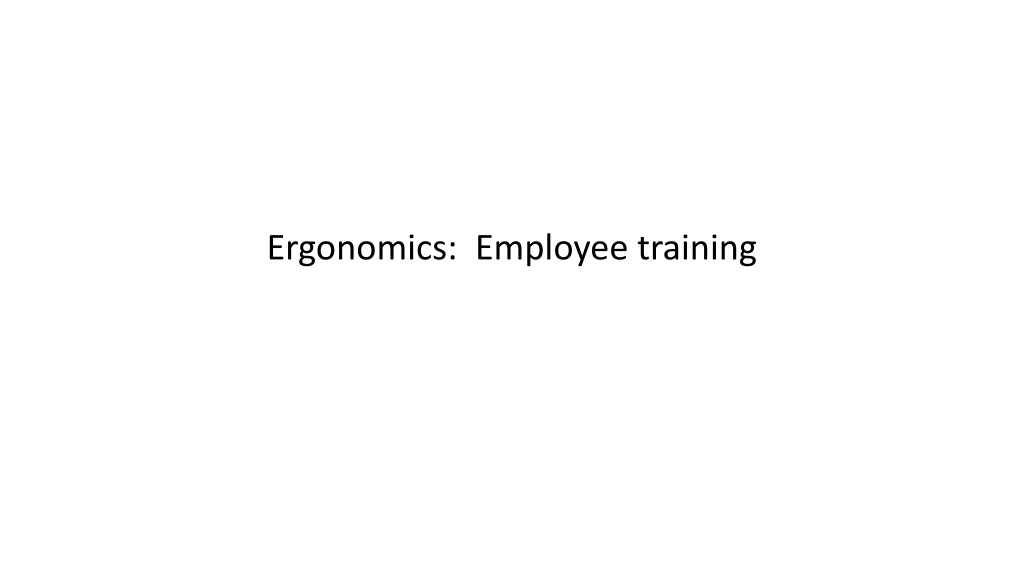Ergonomics: Employee training
This comprehensive training program focuses on ergonomics for employee safety. Employers subject to relevant sections must train employees on safety committee details, ergonomics program, musculoskeletal injury signs, reporting procedures, hazard reporting, controls, and compliance requirements. It also covers safety committee member requirements, including specific members for meatpacking and healthcare industries. The ergonomics program includes risk factor assessment, employee training, and early reporting procedures to prevent serious injuries and claims.
Download Presentation

Please find below an Image/Link to download the presentation.
The content on the website is provided AS IS for your information and personal use only. It may not be sold, licensed, or shared on other websites without obtaining consent from the author. Download presentation by click this link. If you encounter any issues during the download, it is possible that the publisher has removed the file from their server.
E N D
Presentation Transcript
Ergonomics employee training Minnesota Statutes 182.677, subdivision 4 Minnesota OSHA Compliance | Department of Labor and Industry dli.mn.gov
Employee training about ergonomics An employer subject to this section must train all employees on the following: 1. the name of each individual on the employer s safety committee; 2. the facility s ergonomics program; 3. the early signs and symptoms of musculoskeletal injuries and the procedures for reporting them; 4. the procedures for reporting injuries and other hazards; 5. any administrative or engineering controls related to ergonomics hazards that are in place or will be implemented; and 6. the requirements of Minn. Stat. 182.677, subd. 9. dli.mn.gov 3
Safety committee members [Name each individual on the safety committee.] [List names and job titles]
Safety committee members, continued For meatpacking, add the following members: [a certified professional ergonomist (CPE)]; [a licensed, board-certified physician, with preference given to a physician who has specialized experience and training in occupational medicine]; and [at least three workers employed in the employer s facility who have completed a general industry outreach course approved by the commissioner, one of whom must be an authorized employee representative if the employer is party to a collective bargaining agreement]. 5
Safety committee members, continued For health care, add the following members: [list the members of the safe-patient-handling committee]. 6
[This facilitys] ergonomics program [Detail each of the following about how the facility s ergonomics program works.] 1. An assessment to identify and reduce musculoskeletal disorder risk factors in the facility 2. An initial and ongoing training of employees on ergonomics and its benefits, including the importance of reporting early symptoms of musculoskeletal disorders 3. A procedure to ensure early reporting of musculoskeletal disorders to prevent or reduce the progression of symptoms, the development of serious injuries, and lost-time claims
[This facilitys] ergonomics program, continued [Detail each of the following about how the facility s ergonomics program works.] 4. A process for employees to provide possible solutions that may be implemented to reduce, control, or eliminate workplace musculoskeletal disorders 5. Procedures to ensure that physical plant modifications and major construction projects are consistent with program goals 6. Annual evaluations of the ergonomics program and whenever a change to the work process occurs 7. How to access the facility s ergonomics program
Signs, symptoms of musculoskeletal injuries may include Fatigue Numbness Soreness Stiffness Aches and pain (aching or sharp) Swelling Weakness Loss of coordination Discomfort Body parts falling asleep Tenderness Loss of strength Burning Loss of joint movement Tingling Trouble sleeping due to pain
Procedures for reporting early signs, symptoms of MSDs [What should be reported?] [When should a hazard be reported?] [How should workers make reports?] [How will management respond to reports?] [What should workers expect after making a report?] [How will you make sure all workers understand the reporting process?] [How will you make it clear no worker will face retaliation for reporting?] [How might you recognize workers who identify and report hazards?] 10
Procedures for reporting other hazards [What should be reported?] [When should a hazard be reported?] [How should workers make reports?] [How will management respond to reports?] [What should workers expect after making a report?] [How will you make sure all workers understand the reporting process?] [How will you make it clear no worker will face retaliation for reporting?] [How might you recognize workers who identify and report hazards?] 11
Engineering controls for ergonomic hazards, in place or to be implemented [Detail engineering controls for ergonomic hazards that are in place.] [Detail engineering controls for ergonomic hazards that will be implemented.]
Administrative controls for ergonomic hazards, in place or to be implemented [Detail administrative controls for ergonomic hazards that are currently in place.] [Detail administrative controls for ergonomic hazards that will be implemented.]
Reporting encouraged [Detail how reporting is encouraged at the facility.]
Training frequency New employees will be trained prior to starting work. Current employees will receive initial training and ongoing annual training in accordance with the employer s egonomics program. Training will occur during the working hours and employees will be compensated for attending the training at the employer s standard rate of pay. All training will be in a language and with vocabulary the employee can understand.





























